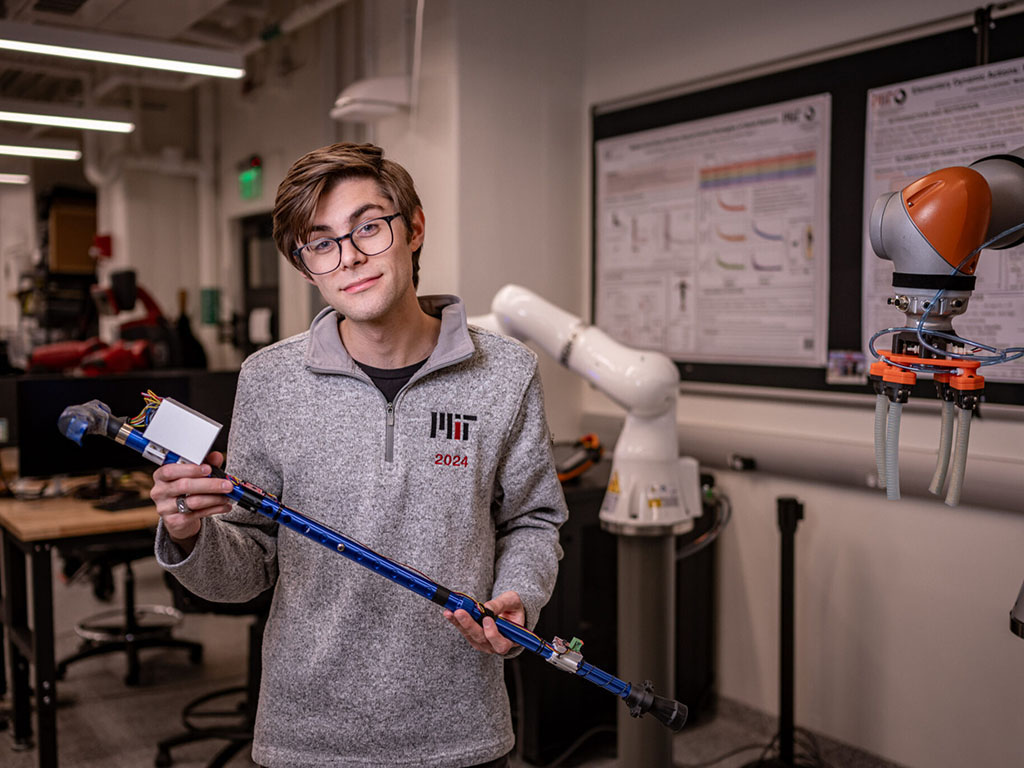An assisted step forward: Max Burns talks about the process, and teamwork, of invention
When people hear the term “inventor”, they often picture someone working alone: Ben Franklin and his kite; Edison and his lightbulb. But Max Burns would like you to picture something else: a team.
The SuperUROP participant from Logan, Ohio just walked with his degree in Mechanical Engineering this spring. Along the way, Burns’s work has been recognized by multiple entities: as an undergraduate, he was a recipient of the Arthur J. Samberg scholarship, and of the Prince Innovation Prize from the Mechanical Engineering Department for his SuperUROP project, an instrumented walking cane. For his coming stint in graduate school at Stanford University, Burns has already received the NSF Graduate Research Fellowship, the Stanford Graduate Fellowship, and the Stanford EDGE (Enhancing Diversity in Graduate Education) Fellowship. All this support is fitting, because Max Burns is all about giving people the support they need. We sat down with him to learn more.
For your SuperUROP project, you built a walking cane with sensing instruments that could gather data about a patient’s balance as they used it. Where did you begin with the development of this project—what inspired it?
I began this project the year before joining SuperUROP, when I was looking for a UROP experience where I could explore assistive technology research. I joined the MIT Newman Laboratory for Human Rehabilitation, where I’ve been advised by graduate student Kaymie Shiozawa and Professor Neville Hogan. I was excited to work with the instrumented cane, because my grandmother relies on a walking cane and struggles with balance issues and falls. After I learned more about balance, I better understood how dangerous falling is for older adults, and the way mobility limitations take away independence and limit millions of people’s personal freedom. From what I learned during this project, I’ve decided to focus on lower limb mobility assistance in my graduate work.
In terms of the project’s development, the cane was actually built by a prior SuperUROP student, Emily Skilling, in 2020, and had been used by my graduate student advisor for some experiments since then. When I joined the project I was tasked with finding some way to quantify static balance ability using the instrumented cane, beyond the data collection which had already been performed. My main contribution–and the focus of my work during SuperUROP–was the development of a method to predict postural sway velocity, which is a metric that provides insight into balance health and fall risk in older adults.
I began by collecting validation data from sixteen young adults, and I designed a feature computation and selection pipeline, which ultimately made a prediction of a subject’s sway velocity for a window of data using linear regression. After finding success with the validation subjects, we moved on to working with eight participants over 65.
Your SuperUROP project isn’t the only way you’ve explored assistive technology, correct–it’s another outgrowth of your primary research interest.
Yes! I helped restart the MIT Assistive Technology Club, where we pair small teams of MIT students with a person who has a disability, who works with them as a codesigner to develop a prototype that improves their daily life. The teams meet with their codesigner every week, to ensure that the project is guided by the needs of the person who will use the device or software. I worked as the club’s project manager, and met with leads from our six teams each week to provide guidance in technical and logistical aspects of their projects, which are really diverse.

